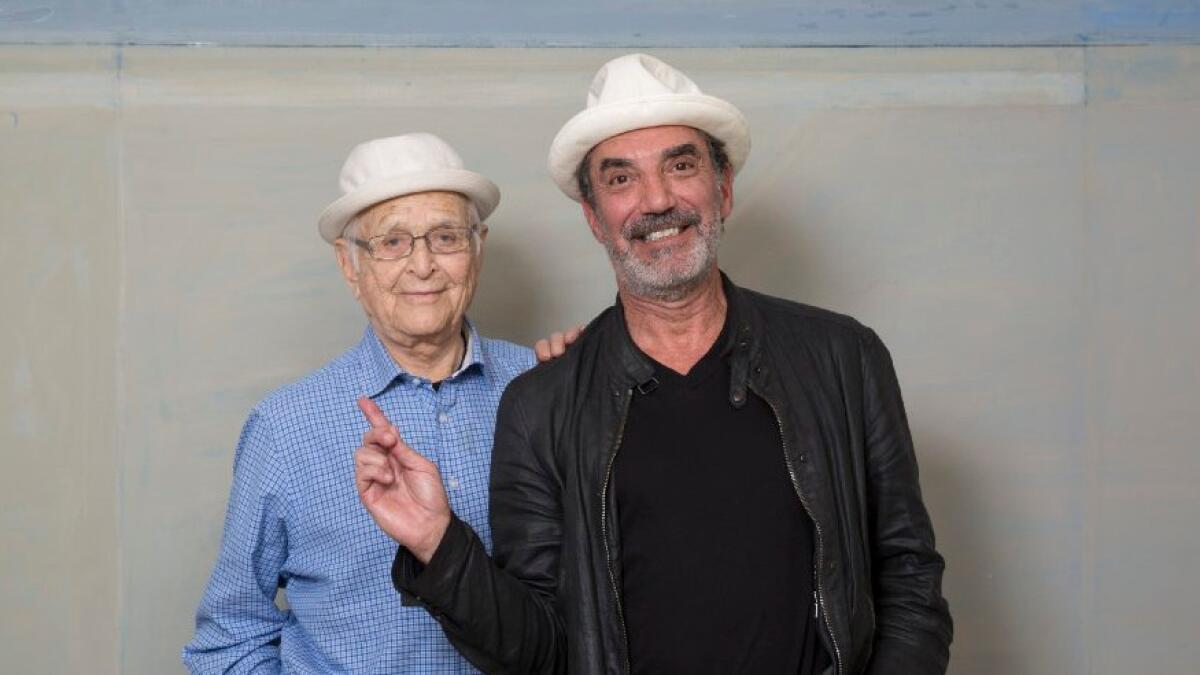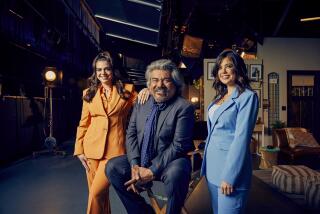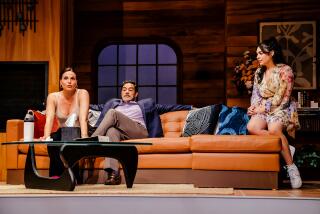When Norman Lear gets with Chuck Lorre, the laughs are king

The man who changed television the first time around is 93 years old.
He lives in a big yellow house -- “sprawling” would not be hyperbole -- overlooking the wild depths of Rustic Canyon. Inside, airy rooms are filled with comfortable furniture, an impressive art collection and, as if on comedic cue, a barfing cat.
“Has he been doing that a lot?” Norman Lear asks as the animal saunters nonchalantly away from the mess, as if it had been made by another cat entirely. “Should we be worried?”
Reassured that it’s just a case of purloined people food, Lear sits back down at his kitchen table. He is waiting for television producer-creator Chuck Lorre, who has just called in from the gate, as he’s been describing his new show, a Latino version of “One Day at a Time.” Lear held his first table reading a few days earlier, shooting begins in a week, and he’s very excited. The show is for Netflix, with a 13-episode season, but it’s still a multi-camera comedy filmed in front of a live audience.
“That’s the only kind I do,” Lear says, laughing.
This is exactly why Lorre has arranged this meeting. Lear is the maestro of the multi-cam, having at one time juggled seven of them concurrently, including such groundbreakers as “All in the Family,” “Maude” and “The Jeffersons.”
But over the years, the multi-camera sitcom, with its live audience laughs and interior staginess, has been increasingly replaced by the more fluid and mobile (outdoor scenes!) single-camera show.
Lorre has been pushing back against this trend for years. Like Lear, Lorre has spent years overseeing several comedies at once, including, in various configurations, “Two and a Half Men,” “Dharma and Greg,” “The Big Bang Theory” and “Mike and Molly.”
But it wasn’t until the debut of “Mom,” in which a contentious mother and daughter find themselves sharing both a house and a 12-step program, that Lorre ventured into Lear’s territory of socially conscious comedy.
So maybe it’s not surprising that he enters Lear’s house hat in hand. Literally.
“Where did you get that hat?” Lear asks immediately. “It’s just like mine.”
Not exactly — Lorre wrangled a white fedora from “Mom’s” costume department, while Lear’s signature topper, which is on his head, seems a bit more sporty. And Lear quickly decides he likes Lorre’s hat better. “I’ll put you in touch with the woman in our costume department,” Lorre says.
This may be the first time Lorre has played haberdasher to Lear, but it’s not the first time he’s approached the master for notes.
“When I was doing ‘Two and a Half Men’ and had agreed to do ‘Big Bang,’ I had no idea how to juggle two shows. I called Norman, who graciously agreed to meet with me. And when I explained why I was there, you said, ‘You’re not going to like the answer.’ Do you remember this?” he asks Lear, who shakes his head, smiling
“He said: ‘You go to where the fire is burning brightest and you try to put it out.’ I thought he was going to give me this magic, mystical answer and he said, ‘No, it’s just very hard.’ ”
Lear laughs. “When I decided I wanted to do something else, I asked Larry Gelbart and Carl Reiner if they wanted to come in and take over — I had about six shows on the air at the time — and they looked at me and said, ‘Are you out of your mind?’ ”
The two men do not know each other well — this is the first time Lorre’s been to Lear’s house -- but they certainly speak the same language, and Lear recently visited the set of “The Big Bang Theory,” causing, Lorre says, every writer on the staff to be “frozen with fear.”
“It was a stressful night,” Lorre said over Lear’s protests, “we wanted you to be proud of us.”
“I thought it was terrific,” Lear said, leaning in to ask who warmed up the audience for the show. Mark Sweet, Lorre answered. “What’s his last name?” Lear asked, once again taking note.
The care and feeding of the audience is important, Lorre said, because the audience can make or break a show. It is the biggest thing that separates the multi-cam comedy, which includes one, from its single camera peers, which do not. An audience is the source of a show’s veracity, and, Lear adds, its comedic energy.
“When it’s really going, and the actors are riding the emotion, it carries them into the next moment. You’re being told on the spot whether something’s working or it’s not because of the laugh, and the actors feed off that.”
As an example, Lear describes a scene from “Maude” in which the audience, which knew something Maude (Bea Arthur) did not, responded with a huge laugh when it was revealed. “And Bea, she just shifts her weight a little and the laugh gets louder, she touches her ear, more laughter. She used it to make the scene stronger.”
“It really is as close to live theater as you get on TV,” Lorre says.
The two men talk about laughter like connoisseurs. They both hate the canned laughter of a laugh track because it cheats both the TV audience and the performers.
“When you hear that belly laugh,” Lear says, “the one where the audience leans forward and comes partway out of their seat, that’s when they’re all in love with the actors.”
This is why they got into the business — to make people laugh, as loudly and as often as they could. Both men seem a bit baffled by the recent genre blending, in which shows like “Nurse Jackie” and “Orange Is the New Black” are often considered comedies.
“Comedy hasn’t changed,” Lear says, “the descriptors have. ‘Orange Is the New Black’ is not a comedy.”
“I am operating with the definition that comedy involves laughter,” says Lorre. “There are serious moments that you let be, but you give the audience release.”
And neither understands the shift away from multi-camera comedies.
“It got uncool, maybe,” Lorre says. “ ’30 Rock’ and ‘The Office’ were suddenly cool, at least to the critical audience. But there’s a critical response and there’s an audience response; ‘Seinfeld’ and ‘Everybody Loves Raymond’ were all great shows.”
He sounds a little defensive, and perhaps he is. None of his shows, including the enormously popular “Big Bang,” has won an Emmy for comedy series; indeed, the last multi-cam to win was “Everybody Loves Raymond,” in 2005 .
“I just don’t think people appreciate the beauty of the thing,” he says.
“Well,” adds Lear, maestro of the multi-cam and national treasure, “most of what you hear about anything is [malarkey]. People will tell you you can’t do just about anything — mention abortion, have a gay character, write funny about cancer. You do it anyway.”
More to Read
From the Oscars to the Emmys.
Get the Envelope newsletter for exclusive awards season coverage, behind-the-scenes stories from the Envelope podcast and columnist Glenn Whipp’s must-read analysis.
You may occasionally receive promotional content from the Los Angeles Times.







